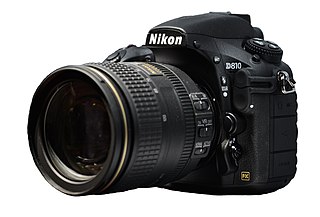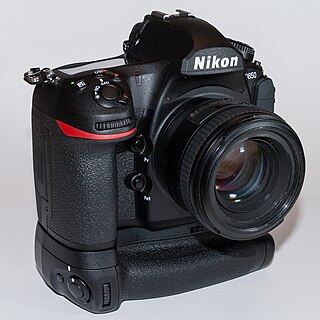 Nikon D7000 with 50mm/1.4 AF-D NIKKOR lens | |
| Overview | |
|---|---|
| Type | Digital single-lens reflex |
| Released | 15 September 2010 |
| Lens | |
| Lens | Interchangeable, Nikon F-mount |
| Sensor/medium | |
| Sensor | 23.6 mm × 15.6 mm Nikon DX format RGB CMOS sensor, 1.5 × FOV crop, 4.78 μm pixel size |
| Maximum resolution | 4,928 × 3,264 (16.2 effective megapixels) |
| Film speed | ISO 100–6400 in 1/3 EV steps, up to 25600 with Hi (boost) menu item |
| Recording medium | Secure Digital, SDHC, SDXC compatible (Dual Slot) and with Eye-Fi WLAN support. Supports Ultra-High Speed (UHS-I) cards. [1] |
| Focusing | |
| Focus | Manual, Auto, Focus-lock, Electronic rangefinder, Live preview and video modes: Subject-tracking, Face-priority, Wide-area, Normal-Area |
| Focus modes | Instant single-servo (AF-S); continuous-servo (AF-C); auto AF-S/AF-C selection (AF-A); Full time AF (AF-F); manual (M) |
| Focus areas | 39-area AF system, Multi-CAM 4800DX AF Sensor Module Area modes: 3D-tracking, Auto-area, Dynamic-area, Single-point |
| Exposure/metering | |
| Exposure modes | Auto modes (auto, auto [flash off]), Advanced Scene Modes (Portrait, Landscape, Sports, Close-up, Night Portrait), programmed auto with flexible program (P), shutter-priority auto (S), aperture-priority auto (A), manual (M), quiet (Q) |
| Exposure metering | TTL 3D Color Matrix Metering II metering with a 2,016 pixel RGB sensor |
| Metering modes | 3D Color Matrix Metering II, Center-weighted and Spot |
| Flash | |
| Flash | Built in Pop-up, Guide number 13m at ISO 100, Standard ISO hotshoe, Compatible with the Nikon Creative Lighting System, featuring commander mode for wireless setups |
| Flash bracketing | 2 or 3 frames in steps of 1/3, 1/2, 2/3, 1 or 2 EV |
| Shutter | |
| Shutter | Electronically-controlled vertical-travel focal-plane shutter |
| Shutter speed range | 30 s to 1/8000 s in 1/2 or 1/3 stops and Bulb, 1/250 s X-sync |
| Continuous shooting | 6 frame/s up to JPEG 100 frames or NEF 10-14 frames |
| Viewfinder | |
| Viewfinder | Optical 0.94× Pentaprism, 100% coverage |
| Image processing | |
| White balance | Auto, Incandescent, Fluorescent, Sunlight, Flash, Cloudy, Shade, Kelvin temperature, Preset |
| General | |
| LCD screen | 3.0-inch 921,000 pixel (VGA x 3 colors) TFT-LCD |
| Battery | Nikon EN-EL15 Lithium-Ion battery |
| Optional battery packs | Nikon MB-D11 battery grip |
| Weight | Approx. 690 g (1.52 lb) without battery, 780 g (1.72 lb) with battery |
| Made in | |
| Chronology | |
| Successor | Nikon D7100 |
| References | |
| Nikon D7000 product homepage | |
The Nikon D7000 [2] is a 16.2-megapixel digital single-lens reflex camera (DSLR) model announced by Nikon on September 15, 2010. It replaced the D90 as the top end consumer camera, by using much of the technology and controls from the earlier D5000, in a larger more robust body similar to the flagship D300 series. In some ways it was superior to the D300S, though for several years the two cameras were both available with the D300 positioned as the flagship in Nikon marketing materials.
Contents
- Feature list
- Optional accessories
- Reception
- Reviews
- Matrix Metering II and detected faces
- User response
- Firmware hacks
- References
- External links
The D7000 offers numerous professional-style features over the D90, such as magnesium alloy body construction, weather and moisture sealing, a 2,016-segment color exposure meter, built-in timed interval exposure features, 39 rather than 11 focus points, dual SD memory card slots, virtual horizon (in live view and viewfinder) and compatibility with older non-CPU autofocus and manual-focus AI and AI-S Nikon F-mount lenses (including an electronic rangefinder with three-segment viewfinder manual focus indication) as well as tilt-shift PC-E lenses. Other built-in features are a wireless flash commander, two user-customizable modes, full HD video with autofocus and mono audio (With support for an external stereo microphone), automatic correction of lateral chromatic aberration and support for GPS and WLAN.
In 2011, the D7000 received four major awards, the Red Dot product design, TIPA's "Best D-SLR Advanced" category, EISA's "European Advanced SLR Camera 2011-2012" and the CameraGP Japan 2011 Readers Award. [3] [4] [5] [6]
The D7000 was superseded by the D7100, announced on February 20, 2013. [7] However, Nikon kept the D7000 in its product lineup for at least several months. [8]























